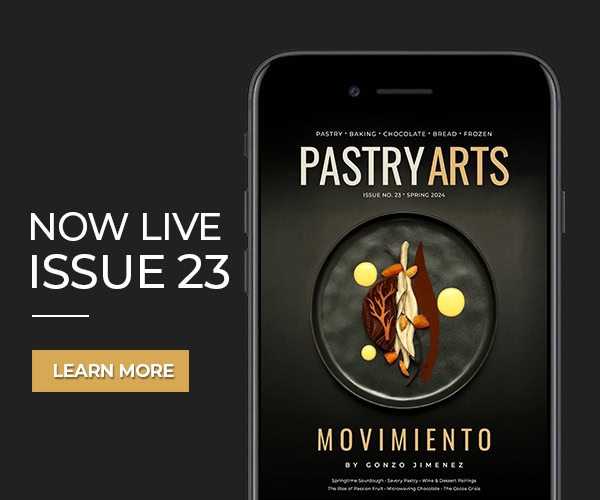By Michael Laiskonis
Culinary Director, Boiron Americas
As a pastry chef, I am constantly considering how I approach flavor in desserts and confections. Of course, our goal first and foremost is to seek out ingredients of the highest quality and expression of flavor, whether it be the true-to-origin characteristics and roast profile of cacao that produces chocolate, the fresh complexity of dairy products, or the peak-season flavor, aroma and color of the global fruit basket. The tools at our disposal for weaving together flavors in both conventional and novel ways are diverse. Chefs can simply draw from classic pairings or seek new ways to achieve surprising results. We can explore the wealth of traditions tied to other cultures, adopt a ‘what grows together, goes together’ approach, or dive into flavor chemistry to arrive at combinations of ingredients that share common volatile compounds. The flavors we seek to highlight then inform the techniques we employ, and whether supporting elements will complement or contrast individual characteristics to create an effect that is greater than merely the sum of their parts.
One tool that I have found increasingly beneficial in my own process involves more thoughtful sensory analysis of the products that I use on a daily basis, as well as paying closer attention to the provenance of an ingredient – the story of where it comes from and how it is produced. Such deeper understanding can be useful in unlocking inspiration and harnessing new avenues of creativity. While taste is ultimately subjective, we can train ourselves to appreciate ingredients in a more systematic way, and to express their characteristics using a common language. In fact, our industry already provides many examples, such as the standardized analysis of products like wine, coffee, and chocolate. What’s exciting to me is when we apply that same approach to fruit.
Drawing from over 80 years of expertise in fruit, Les vergers Boiron has created an accessible tool for chefs known as Fruitology®. Initially developed as a way for the company to talk about fruit internally – from sourcing to production to quality control – this discipline has been expanded to provide culinary professionals the ability to understand the different sensory characteristics of a fruit purée (appearance, taste, and texture) in order to perfect their recipes.
Fruitology® is based on sensory analysis, a scientific discipline that uses human senses as a measurement. We can precisely measure quality aspects in Brix or pH, but no instrument can replace the individual’s ultimate experience of, say, the sugar and acid balance of perfectly ripe fruit. Product characteristics are thus evaluated with all the five senses (sight, touch, sound, smell, and taste). Within the sensory labs at Les vergers Boiron, a panel of experts is trained to describe fruit purées according to previously defined descriptors, to which they assign an intensity score. The data obtained is then used to create flavor profiles of each fruit and to assist chefs on three levels: identifying a fruit’s primary characteristics, crafting a language for comparing fruits of similar type, and fueling creativity.
Identifying the characteristics of a fruit purée
Like any edible product, fruit has its own specific characteristics, which play an essential role when tasting the fruit and the products made from it. Fruitology® is designed to meet the specific needs of identifying product characteristics and the subtleties of evaluating them. Combined with the backstory of origin and selected variety of the fruit, it’s like having a detailed passport for each purée.
Comparing several purées with the same flavor
Fruitology® is a guide for tasting and evaluating a fruit purée. It can also be used to compare different purées of the same flavor and define their specific characteristics. Les vergers Boiron used its expertise to develop a new discipline with a language based on the methods of sensory analysis. The tools are designed for chefs – and all operators in the fruit sector – particularly those who work with fruit purées.
Developing creativity
Understanding the characteristics of fruit and its transformation into purée opens the door to creativity. Thoughtful analysis of complex aromatic notes can inspire a better blend of flavors. At a time when our guests and customers have increasing demands and seek new experiences, pastry professionals can use this knowledge to offer desserts and confections that exceed their expectations.
For more information on Fruitology®, visit: https://offers.my-vb.com/fr/livre-blanc-de-la-fruitologie-integral
MANGO-HIBISCUS ‘ROULEAU’
A simple example of how I have used this tool toward a creative end is reflected in a refined interpretation of a fruit ‘roll-up’ incorporating mango purée. The flavor wheel below highlights those core elements of the purée – a blend of the Alphonso and Kesar varieties – that express the optimum mango profile. Transforming the mango into a classic pâte de fruit concentrates the jammy sweetness and rich aromatics, and I then sought to complement the mango with a touch of floral acidity from hibiscus, appearing in the form of marshmallow. Tying these two components together is the spicy anise note of Thai basil, to draw out the green, piney aspect provided in part by the unique Kesar mango.
Yield: approximately 36 petit four-style confections
Mango Pâte de Fruit
- 170 g Boiron Mango purée
- 80 g Boiron Apricot purée
- 220 g granulated sugar, divided
- 6 g yellow pectin
- 35 g glucose syrup
- 5 g citric acid
1. Place the purées into a saucepan and heat to 104°F (40°C).
2. Combine 25 g of the sugar and the pectin and whisk into the purée. Bring to a boil over medium heat, stirring continually.
3. Add the remaining 195 g sugar and the glucose in multiple additions; continue to cook to a final temperature of 223°F (106°C). Remove from heat and stir in the citric acid.
4. Immediately pour into a 4.72ʺ (12 cm) square frame and allow to cool and set at room temperature.
Hibiscus Infusion
- 120 g water
- 10 g hibiscus flower, dried
1. Heat the water to a simmer and pour over the hibiscus. Allow to infuse 1 hour and strain.

Hibiscus Marshmallow
- 4.5 g gelatin powder (225-bloom)
- 25 g water, cold
- 50 g glucose syrup, divided
- 60 g Hibiscus Infusion, divided
- 70 g granulated sugar
1. In a stand mixer bowl, hydrate the gelatin in the water. Add 25 g of the glucose syrup and 10 g of the Hibiscus Infusion and reserve.
2. Combine the remaining 50 g of the Hibiscus Infusion with the sugar and the remaining 25 g of glucose syrup in a saucepan and bring to a boil over medium heat. Continue to cook to a final temperature of 230°F (110°C).
3. Remove from the heat and pour the cooked syrup over the gelatin mixture and whip on high speed for 7-8 minutes, or until the mixture is light and fluffy and has cooled to approximately 75°F (24°C).
4. Transfer the mixture into an acetate sheet lightly coated with pan spray and spread the marshmallow to a thin layer. Allow to set for several hours.
Assembly
- Thai basil leaves
1. Remove the mango pâte de fruit from the frame and slice into 1-2 mm pieces. Reserve.
2. Cut the Hibiscus Marshmallow into rectangles measuring 4.72ʺ (12 cm) long by 0.4ʺ (1 cm) wide. Place the marshmallow onto the Mango Pâte de Fruit and loosely roll. Garnish with tiny Thai basil leaves.
(This article appeared in the Fall 2023 issue of Pastry Arts Magazine)







You must be logged in to post a comment.